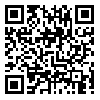Volume 15, Issue 1 (3-2015)
Modares Mechanical Engineering 2015, 15(1): 185-193 |
Back to browse issues page
Download citation:
BibTeX | RIS | EndNote | Medlars | ProCite | Reference Manager | RefWorks
Send citation to:



BibTeX | RIS | EndNote | Medlars | ProCite | Reference Manager | RefWorks
Send citation to:
Mehrabani Yeganeh E, Liaghat G H, Pol M H. Experimental investigation of quasi-static perforation on laminated glass epoxy composites by indenters with different geometries. Modares Mechanical Engineering 2015; 15 (1) :185-193
URL: http://mme.modares.ac.ir/article-15-8577-en.html
URL: http://mme.modares.ac.ir/article-15-8577-en.html
Abstract: (5253 Views)
This paper, experimentally evaluates the effects of indenter geometry on quasi-static perforation process of laminated woven glass epoxy composites. Low loading rate tests were performed, using six indenters with blunt, hemispherical, conical (cone angle of 37˚ and 90˚) and ogival (caliber radius head of 1.5 and 2.5) nose shapes. Composite behaviors like energy absorption, contact force, failure mechanisms and friction force were investigated for different indenter shapes. Hand lay-up method has been used to manufacture composite targets with 18 layers of 2D woven glass fibers of 45% fiber volume fraction. The epoxy system is made of epon 828 resin with jeffamine D400 as the curing agent. The results show that the load displacement curve is divided to five areas. Some of these areas may have higher or lower magnitude, depending on indenter nose shape. The highest contact force is exhibited by unsharpened indenter. The lowest contact force and so the best performance is seen in ogival (CRH=2.5) indenter. Comparing absorbed energies shows that for an identical dent depth, the amount of absorbed energy is major for unsharpened indenters. The 37˚ conical indenter needs the highest energy for perforation, which is 2.6 times more than blunt indenter’s.
Keywords: Quasi-static perforation, indenter geometry, Contact Force, energy absorption, laminated woven composite
Article Type: Research Article |
Subject:
Stress Analysis|Damage Mechanics|Impact Mechanics|Composites
Received: 2014/09/6 | Accepted: 2014/11/8 | Published: 2014/11/30
Received: 2014/09/6 | Accepted: 2014/11/8 | Published: 2014/11/30
| Rights and permissions | |
 |
This work is licensed under a Creative Commons Attribution-NonCommercial 4.0 International License. |







